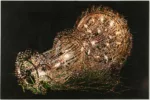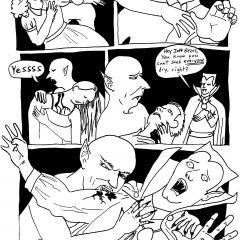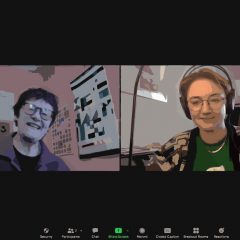[Our U.K. correspondent, Katie, takes a trip to Seoul and reviews a show combining calculation and contemporary art. — the Artblog editors]
To most people, mathematics is something of an unknown world. At worst, it can be intimidating; at best, filled with secrets that can’t be accessed without a significant amount of education. Conceived as a look at the artist’s take on mathematics, Matrix: Mathematics_Heart of Gold and the Abyss at Seoul’s National Museum of Modern and Contemporary Art was timed to coincide with the International Congress of Mathematicians, taking place in the same city. The “Heart of Gold,” explains the exhibition literature, is the “essential truth” pursued by mathematicians; the “Abyss” is Heidegger’s Abgrund–the unseen parts of the world around us to which art persists in pointing.
Making math more accessible
It’s a daring move to set up such a surprising duality, but proposing a controversial binary has something to offer, unlike the confused rhetoric in the exhibition introduction about the mathematization of “modern” society. In fact, mathematics has been shaping our societies since records began, though the rise of computing has made the uses of its products more and more tangible in recent years.
However, as contemporary mathematicians’ work becomes more and more specialised, their most exciting discoveries become more and more difficult to link with the experience of those outside the discipline. How, then, can these two worlds approach one another? Here we see artists taking a wide variety of approaches to the topic, interesting as much for the connections missed as for those made.
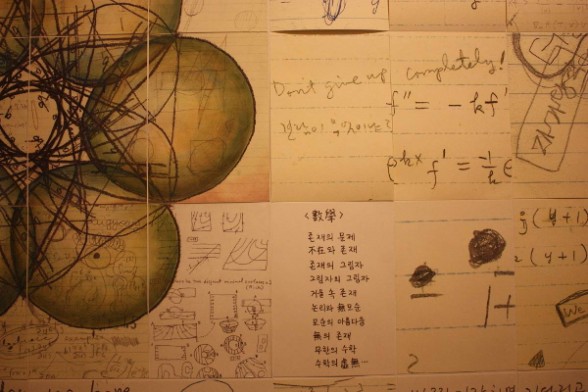
One of the more successful paths to take in such interdisciplinary work is to focus on the experience of the humans investigating these topics. Eraterina Eremenko’s beautifully-shot documentaries are one such example; a number of mathematicians explain and enthuse about their work, their excitement coming across even when the subject matter cannot. Heejin Song’s installation room supplements the mathematician’s words in a different way–a room papered with extracts from mathematician Jaigyoung Choe’s notebooks, which spread, interspersed, with seductive abstract drawings, scribbled notes and doodles as an insight into a working mind.
The abstraction involved in creating this world of numbers and symbols can also serve to alienate a public not familiar with its languages, as exemplified in the giant projection work from randomwalks. This installation claims to show the current issues facing Seoul, with its colourful projected landscapes; but just as the statistics filling our lives can obscure as much as they elucidate, even those with descriptive labels offer no real opportunity to glean information from the zooming displays.
Creativity in numbers
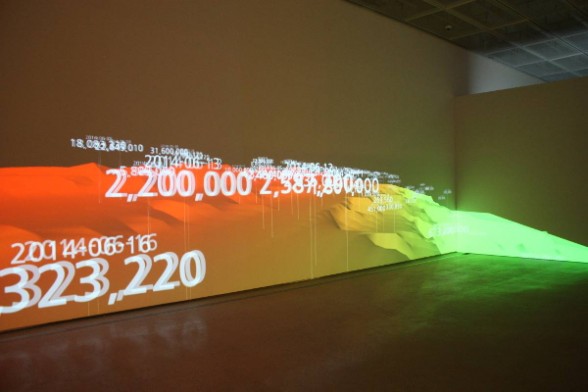
Projections from randomwalks.
The long line of images presented by graphic designers Suki & Min is the result of an interesting investigation of incomprehension that the artists term “wrong abstraction”. The source of the images was Korea’s College Scholastic Ability Test for 1997: Mathematics, a notoriously difficult example of a 27-question test that can determine the course of the rest of a student’s life. The questions have been transformed into an intriguing set of white lines describing strange structures and relationships, with only the question numbers left intact.
It’s impossible to glean the content of these questions, but though perhaps the original intention is lost, there is clearly some logic in operation in each one, in the selection of one line over another, or the subtle suggestion of a table by a well-placed corner. Though labelled “wrong,” these constructed systems of form and colour show an inventive attitude to notation and selection that is absolutely appropriate to the mathematical spirit.
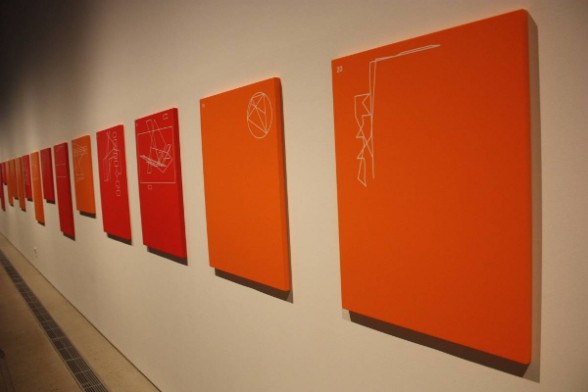
Differences in math methodology
One work in this show cast an entirely different light on the question of mathematical culture: an installation in nine parts based on the Luo Shu square; the artist, Jiwon Yu, describes the work as an exploration of the physical movements made by Koreans in solving mathematical problems, even as they use “Western” notation. Neither I nor my companion, an American-born Korean-English translator, were able to make sense of the displays; it seems that there are differences between the East Asian experience of mathematics and the one with which I grew up that must be omitted by the abstracted symbols that we share.
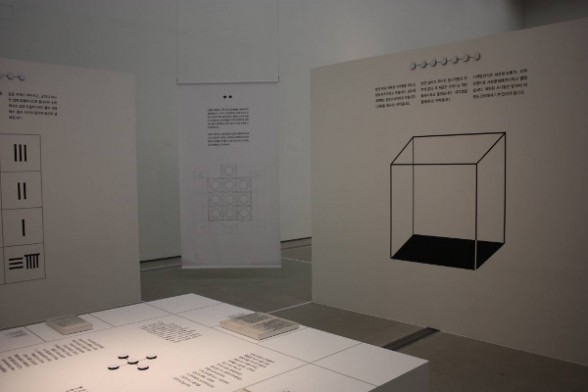
A few days earlier, at the ICM itself, I saw an exhibition by Imaginary, a wonderful organisation that flies in the face of the traditional stereotype of the indifferent mathematician by devoting itself to promoting better communication of mathematics to a general audience. They collect interesting texts, images, and programs that are available for use by anyone who wants to put together their own exhibition; on this occasion, many of the mathematicians were on hand to explain the content of their work.
The organisation also publishes short texts on contemporary mathematics, called Snapshots, written in collaboration with journalists whose focus is to make them intelligible to a wider audience. As an example, this text discusses the incredibly complex questions that can be asked about simple arrangements of lines–the subject of debates that connect playful 19th-century rhymes with cutting-edge mathematics. In the art world, such an explicit unravelling of an artwork would be sacrilegious, but the movement dedicated to opening up the obscure language of mathematics is gaining real momentum.

Disproving stereotypes
On the same day, Professor Günter Ziegler gave a talk unpacking some of the images associated with mathematics, from textbook covers through the decades to an image of a 4-year-old girl playing with a calculator, which was used to illustrate an article on women in mathematics. This was a fascinating talk: an undeniable look into the abyss through its examination of the assumptions and associations that build up the popular image of mathematics.
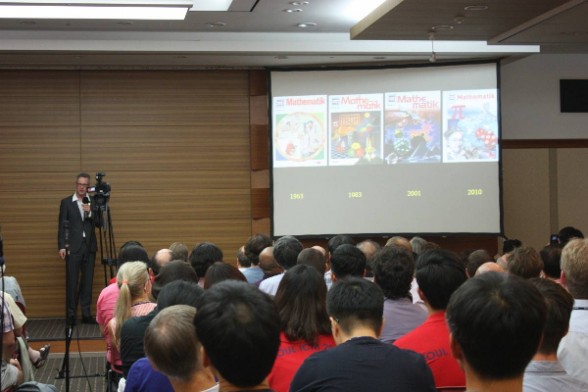
The text on the MATRIX website makes a point of stating that “the idea of a mathematized society should not carry the negative connotation of a cold, calculating world”. Speaking with mathematicians about their work, it is clear that for them, mathematics is anything but cold; what’s more, many show a real desire to share the excitement that they feel. A middle ground may be different to find, but perhaps this experimentation is worth it. Though they may appear to inhabit very different worlds, both artists and mathematicians pursue their strange work out of a sincere enchantment with topics that are often evasive and cannot be pinned down.
Matrix: Mathematicians_Heart of Gold and the Abyss is on view at the National Museum of Modern and Contemporary Art, Korea, until Jan. 15, 2015.


